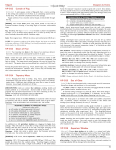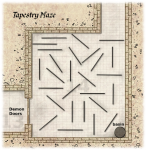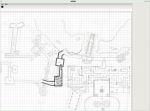squeen
8, 8, I forget what is for
The following is a short excerpt from an area my players are about to explore. In writing it up, I've tried to focus on Byrce-ian Design principles, and struggled to stay brief (not normally my strong-suit) and further develop a layout that serves "at-the-table" usability.
Noteworth items: In addition to segregating the PC's immediately observable data (i.e. the "safe read aloud") just below the section heading, and separated it from discoverable details by a horizontal line, I've also added a few "DM Hints" at the start of this preamble inside gray brackets (e.g. [Unlit,odor]). These are intended as clues for the senses [sight,sound,smell,touch], and sometimes are color-matched to gray text in the body of the description. Honestly, I'm not so sure about the color-matching scheme, particular gray, but I let it go for now.
Also, the decision to spec [Unlit] instead of [Lit], addresses a personal failing of mine as a DM to forget the PCs can't see much by torchlight and just barrel into the full description. Hopefully, this little reminder will restrain me. (Also, [dark] might be better a better descriptor than [Unlit]. TDB...)
Lastly, some background on the setting. These "Dungeon & Drains" exist beneath a Royal Palace. This section are the demesne of a dead(?) Witch-Queen that, despite the well-know proximity, has been walled-off and avoided for decades because it is filled with deadly traps and guardians. Hence the difficulty in penetrating the dungeon is not necessarily a design-flaw, but more an intended feature---possibly requiring a higher-level party to penetrate. This section is intended to be a barrier. Treasure lies beyond. If it's too difficult, it's easy to avoid.
Stats Blocks only apply to Swords & Wizardry. Numbers next to attack-types are (THAC0,damage). And the LORE subsection just ties things into my home campaign and so should be ignored.
Feedback on form and function will be greatly appreciate. The content is relevant to this thread because there are many illusions, that (if treated EOTB-style), (a) won't dissolve at first touch, and (b) have the potential for dramatic demonstration of disbelief (i.e. running through the broken glass, ignoring the attacking knight, etc.). I'm curious as to how they play out at my table this weekend, and would love to hear any flaws y'all spot in the set-ups. You can even just tell me flat-out "Hey squeen! This stuff is really boring!". Seriously. I wanna know.
Lastly, below is a partial area map (done in homage to the Moneyblood Design style)---that contains errors/omissions and definately needs to be redone. Towards that end. I am programming a little CAD tool that will help me do better/faster maps in the future. Still, I hope it's enough to help orient reviewers despite a few chopped-off rooms (12 to the left & 18 to the right).

Here are some thumbnails of the keyed pages, and a higher-resolution PDF attached to the post.


I believe it was @Melan who first said here, "I'll expect your reply seconds after I press the Send button."
(not really...but I am rather excited to hear some comments---It's surprising how much more polished this section, originally written-up this past January around the time of DP's One Page Design Contest, became when I decided to showing it off to the public.)
Cheers
Noteworth items: In addition to segregating the PC's immediately observable data (i.e. the "safe read aloud") just below the section heading, and separated it from discoverable details by a horizontal line, I've also added a few "DM Hints" at the start of this preamble inside gray brackets (e.g. [Unlit,odor]). These are intended as clues for the senses [sight,sound,smell,touch], and sometimes are color-matched to gray text in the body of the description. Honestly, I'm not so sure about the color-matching scheme, particular gray, but I let it go for now.
Also, the decision to spec [Unlit] instead of [Lit], addresses a personal failing of mine as a DM to forget the PCs can't see much by torchlight and just barrel into the full description. Hopefully, this little reminder will restrain me. (Also, [dark] might be better a better descriptor than [Unlit]. TDB...)
Lastly, some background on the setting. These "Dungeon & Drains" exist beneath a Royal Palace. This section are the demesne of a dead(?) Witch-Queen that, despite the well-know proximity, has been walled-off and avoided for decades because it is filled with deadly traps and guardians. Hence the difficulty in penetrating the dungeon is not necessarily a design-flaw, but more an intended feature---possibly requiring a higher-level party to penetrate. This section is intended to be a barrier. Treasure lies beyond. If it's too difficult, it's easy to avoid.
Stats Blocks only apply to Swords & Wizardry. Numbers next to attack-types are (THAC0,damage). And the LORE subsection just ties things into my home campaign and so should be ignored.
Feedback on form and function will be greatly appreciate. The content is relevant to this thread because there are many illusions, that (if treated EOTB-style), (a) won't dissolve at first touch, and (b) have the potential for dramatic demonstration of disbelief (i.e. running through the broken glass, ignoring the attacking knight, etc.). I'm curious as to how they play out at my table this weekend, and would love to hear any flaws y'all spot in the set-ups. You can even just tell me flat-out "Hey squeen! This stuff is really boring!". Seriously. I wanna know.
Lastly, below is a partial area map (done in homage to the Moneyblood Design style)---that contains errors/omissions and definately needs to be redone. Towards that end. I am programming a little CAD tool that will help me do better/faster maps in the future. Still, I hope it's enough to help orient reviewers despite a few chopped-off rooms (12 to the left & 18 to the right).

Here are some thumbnails of the keyed pages, and a higher-resolution PDF attached to the post.


I believe it was @Melan who first said here, "I'll expect your reply seconds after I press the Send button."
(not really...but I am rather excited to hear some comments---It's surprising how much more polished this section, originally written-up this past January around the time of DP's One Page Design Contest, became when I decided to showing it off to the public.)
Cheers
Attachments
-
158.2 KB Views: 6
Last edited:




